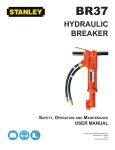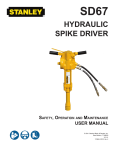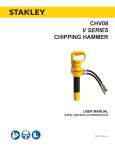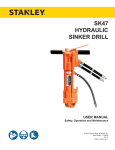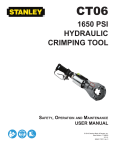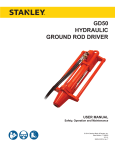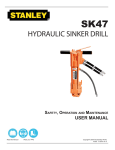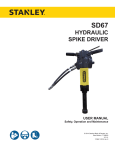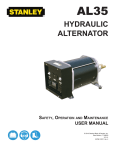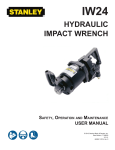Download Stanley Proto Industrial Tools BR89 User's Manual
Transcript
BR89 Hydraulic breaker Safety, Operation and Maintenance USER MANUAL © 2011 Stanley Black & Decker, Inc. New Britain, CT 06053 U.S.A. 70063 2/2011 Ver. 4 Table of contents Safety symbols...................................................................................................................................................4 Safety Precautions...........................................................................................................................................5 Tool stickers & tags.........................................................................................................................................7 Hose types.............................................................................................................................................................8 Hose recommendations...................................................................................................................................9 Figure 1. Typical Hose Connections........................................................................................................9 Htma requirements..........................................................................................................................................10 Operation............................................................................................................................................................. 11 Tool protection & care.................................................................................................................................12 Troubleshooting.............................................................................................................................................13 Charging the accumulator..........................................................................................................................14 Figure 2. Charging the Accumulator....................................................................................................15 Specifications....................................................................................................................................................16 Accessories.......................................................................................................................................................16 Test Equipment..................................................................................................................................................16 Service tools.....................................................................................................................................................16 br89 parts illustration.................................................................................................................................17 BR89 parts list...................................................................................................................................................18 IMPORTANT To fill out a Product Warranty Recording form, and for information on your warranty, visit Stanleyhydraulic.com and select the Warranty tab. (Note: the warranty recording form must be submitted to validate the warranty). SERVICING THE STANLEY HYDRAULIC BREAKER. This manual contains safety, operation, and routine maintenance instructions. Stanley Hydraulic Tools recommends that servicing of hydraulic tools, other than routine maintenance, must be performed by an authorized and certified dealer. Please read the following warning. WARNING SERIOUS INJURY OR DEATH COULD RESULT FROM THE IMPROPER REPAIR OR SERVICE OF THIS TOOL. REPAIRS AND / OR SERVICE TO THIS TOOL MUST ONLY BE DONE BY AN AUTHORIZED AND CERTIFIED DEALER. For the nearest authorized and certified dealer, call Stanley Hydraulic Tools at the number listed on the back of this manual and ask for a Customer Service Representative. BR89 User Manual ◄ 3 Safety symbols Safety symbols and signal words, as shown below, are used to emphasize all operator, maintenance and repair actions which, if not strictly followed, could result in a life-threatening situation, bodily injury or damage to equipment. This is the safety alert symbol. It is used to alert you to potential personal injury hazards. Obey all safety messages that follow this symbol to avoid possible injury or death. DANGER This safety alert and signal word indicate an imminently hazardous situation which, if not avoided, will result in death or serious injury. WARNING This safety alert and signal word indicate a potentially hazardous situation which, if not avoided, could result in death or serious injury. CAUTION This safety alert and signal word indicate a potentially hazardous situation which, if not avoided, could result in death or serious injury. CAUTION This signal word indicates a potentially hazardous situation which, if not avoided, may result in property damage. NOTICE This signal word indicates a situation which, if not avoided, will result in damage to the equipment. IMPORTANT This signal word indicates a situation which, if not avoided, may result in damage to the equipment. Always observe safety symbols. They are included for your safety and for the protection of the tool. LOCAL SAFETY REGULATIONS Enter any local safety regulations here. Keep these instructions in an area accessible to the operator and maintenance personnel. 4 ► BR89 User Manual Safety Precautions Tool operators and maintenance personnel must always comply with the safety precautions given in this manual and on the stickers and tags attached to the tool and hose. These safety precautions are given for your safety. Review them carefully before operating the tool and before performing general maintenance or repairs. Supervising personnel should develop additional precautions relating to the specific work area and local safety regulations. If so, place the added precautions in the space provided in this manual. The BR89 Hydraulic Breaker will provide safe and dependable service if operated in accordance with the instructions given in this manual. Read and understand this manual and any stickers and tags attached to the tool and hoses before operation. Failure to do so could result in personal injury or equipment damage. • Operator must start in a work area without bystanders. The operator must be familiar with all prohibited work areas such as excessive slopes and dangerous terrain conditions. • Establish a training program for all operators to ensure safe operation. • Do not operate the tool unless thoroughly trained or under the supervision of an instructor. • Always wear safety equipment such as goggles, gloves, ear, head, and breathing protection, and safety shoes at all times when operating the tool. • Do not inspect, carry or clean the tool while the hydraulic power source is connected. Accidental engagement of the tool can cause serious injury. • Supply hoses must have a minimum working pressure rating of 2500 psi/175 bar. • Be sure all hose connections are tight. • The hydraulic circuit control valve must be in the OFF position when coupling or uncoupling the tool. Wipe all couplers clean before connecting. Use only lint-free cloths. Failure to do so may result in damage to the quick couplers and cause overheating of the hydraulic system. • Do not operate the tool at oil temperatures above 140 °F/60 °C. Operation at higher oil temperatures can cause operator discomfort and may damage the tool. Never come in contact with the tool bit, the bit can get hot. • Do not operate a damaged, improperly adjusted, or incompletely assembled tool. • Do not weld, cut with an acetylene torch, or hardface the tool bit. • To avoid personal injury or equipment damage, all tool repair, maintenance and service must only be performed by authorized and properly trained personnel. • Do not exceed the rated limits of the tool or use the tool for applications beyond its design capacity. • Always keep critical tool markings, such as labels and warning stickers legible. • Always replace parts with replacement parts recommended by Stanley Hydraulic Tools. • Check fastener tightness often and before each use daily. • Never operate the tool if you cannot be sure that underground utilities are not present. • Do not wear loose fitting clothing when operating the tool. BR89 User Manual ◄ 5 Safety Precautions • Warning: Hydraulic fluid under pressure could cause skin injection injury. If you are injured by hydraulic fluid, get medical attention immediately. • Keep all body parts away from the working tool. • When handling material or the tool bit, wear your (PPE) Personal Protection Equipment. • Be observant of the hydraulic hoses lying about the work area, they can be a tripping hazard. • Always de-energize the hydraulic system when changing a tool bit. • Take caution when changing a tool bit, tool bits can get very hot. • Never use the tool in an explosive atmosphere, sparks from the breaking process could ignite explosive gas. • Use proper lifting techniques when handling the tool, get help from a co-worker and do not over-reach. • Use proper protection from falling or flying debris, keep bystanders at a safe distance. • Do not exceed the rated flow and pressure. See Specifications in this manual for correct flow rate and pressure rating. Rapid failure of the internal seals may result. WARNING Exposure to crystalline Silica (sometimes called “silica dust”) as a result of breaking, drilling, or hammering of rock, concrete, asphalt or other materials may cause Silicosis (a serious lung disease), silicosis-related illnesses, cancer, or death. Respiratory protection is highly recommended when working with materials containing Silica Dust. Always wear a respirator approved for protection against crystalline silica. 6 ► BR89 User Manual Tool stickers & tags 10180 Caution Decal 13842 BR89 Name Decal NOTE: THE INFORMATION LISTED ON THE STICKERS SHOWN, MUST BE LEGIBLE AT ALL TIMES. REPLACE DECALS IF THEY BECOME WORN OR DAMAGED. REPLACEMENTS ARE AVAILABLE FROM YOUR LOCAL STANLEY DISTRIBUTOR. The safety tag (p/n 15875) at right is attached to the tool when shipped from the factory. Read and understand the safety instructions listed on this tag before removal. We suggest you retain this tag and attach it to the tool when not in use. DA N G ER 1. FAILURE TO USE HYDRAULIC HOSE LABELED AND CERTIFIED AS NON-CONDUCTIVE WHEN USING HYDRAULIC TOOLS ON OR NEAR ELECTRICAL LINES MAY RESULT IN DEATH OR SERIOUS INJURY. BEFORE USING HOSE LABELED AND CERTIFIED AS NONCONDUCTIVE ON OR NEAR ELECTRIC LINES BE SURE THE HOSE IS MAINTAINED AS NON-CONDUCTIVE. THE HOSE SHOULD BE REGULARLY TESTED FOR ELECTRIC CURRENT LEAKAGE IN ACCORDANCE WITH YOUR SAFETY DEPARTMENT INSTRUCTIONS. 2. A HYDRAULIC LEAK OR BURST MAY CAUSE OIL INJECTION INTO THE BODY OR CAUSE OTHER SEVERE PERSONAL INJURY. A. DO NOT EXCEED SPECIFIED FLOW AND PRESSURE FOR THIS TOOL. EXCESS FLOW OR PRESSURE MAY CAUSE A LEAK OR BURST. B. DO NOT EXCEED RATED WORKING PRESSURE OF HYDRAULIC HOSE USED WITH THIS TOOL. EXCESS PRESSURE MAY CAUSE A LEAK OR BURST. C. CHECK TOOL HOSE COUPLERS AND CONNECTORS DAILY FOR LEAKS. DO NOT FEEL FOR LEAKS WITH YOUR HANDS. CONTACT WITH A LEAK MAY RESULT IN SEVERE PERSONAL INJURY. DA N G ER D. DO NOT LIFT OR CARRY TOOL BY THE HOSES. DO NOT ABUSE HOSE. DO NOT USE KINKED, TORN OR DAMAGED HOSE. 3. MAKE SURE HYDRAULIC HOSES ARE PROPERLY CONNECTED TO THE TOOL BEFORE PRESSURING SYSTEM. SYSTEM PRESSURE HOSE MUST ALWAYS BE CONNECTED TO TOOL “IN” PORT. SYSTEM RETURN HOSE MUST ALWAYS BE CONNECTED TO TOOL “OUT” PORT. REVERSING CONNECTIONS MAY CAUSE REVERSE TOOL OPERATION WHICH CAN RESULT IN SEVERE PERSONAL INJURY. 4. DO NOT CONNECT OPEN-CENTER TOOLS TO CLOSEDCENTER HYDRAULIC SYSTEMS. THIS MAY RESULT IN LOSS OF OTHER HYDRAULIC FUNCTIONS POWERED BY THE SAME SYSTEM AND/OR SEVERE PERSONAL INJURY. 5. BYSTANDERS MAY BE INJURED IN YOUR WORK AREA. KEEP BYSTANDERS CLEAR OF YOUR WORK AREA. 6. WEAR HEARING, EYE, FOOT, HAND AND HEAD PROTECTION. 7. TO AVOID PERSONAL INJURY OR EQUIPMENT DAMAGE, ALL TOOL REPAIR MAINTENANCE AND SERVICE MUST ONLY BE PERFORMED BY AUTHORIZED AND PROPERLY TRAINED PERSONNEL. I M P O R T A N T I M P O R T A N T READ OPERATION MANUAL AND SAFETY INSTRUCTIONS FOR THIS TOOL BEFORE USING IT. READ OPERATION MANUAL AND SAFETY INSTRUCTIONS FOR THIS TOOL BEFORE USING IT. USE ONLY PARTS AND REPAIR PROCEDURES APPROVED BY STANLEY AND DESCRIBED IN THE OPERATION MANUAL. USE ONLY PARTS AND REPAIR PROCEDURES APPROVED BY STANLEY AND DESCRIBED IN THE OPERATION MANUAL. TAG TO BE REMOVED ONLY BY TOOL OPERATOR. TAG TO BE REMOVED ONLY BY TOOL OPERATOR. SEE OTHER SIDE SEE OTHER SIDE SAFETY TAG P/N 15875 (Shown smaller then actual size) BR89 User Manual ◄ 7 Hose types The rated working pressure of the hydraulic hose must be equal to or higher than the relief valve setting on the hydraulic system. There are three types of hydraulic hose that meet this requirement and are authorized for use with Stanley Hydraulic Tools. They are: Certified non-conductive — constructed of thermoplastic or synthetic rubber inner tube, synthetic fiber braid reinforcement, and weather resistant thermoplastic or synthetic rubber cover. Hose labeled certified nonconductive is the only hose authorized for use near electrical conductors. Wire-braided (conductive) — constructed of synthetic rubber inner tube, single or double wire braid reinforcement, and weather resistant synthetic rubber cover. This hose is conductive and must never be used near electrical conductors. Fabric-braided (not certified or labeled non-conductive) — constructed of thermoplastic or synthetic rubber inner tube, synthetic fiber braid reinforcement, and weather resistant thermoplastic or synthetic rubber cover. This hose is not certified non-conductive and must never be used near electrical conductors. hOSE SAFETY TAGS To help ensure your safety, the following DANGER tags are attached to all hose purchased from Stanley Hydraulic Tools. DO NOT REMOVE THESE TAGS. If the information on a tag is illegible because of wear or damage, replace the tag immediately. A new tag may be obtained from your Stanley Distributor. DA N G ER DA N G ER 1. FAILURE TO USE HYDRAULIC HOSE LABELED AND CERTIFIED AS NON-CONDUCTIVE WHEN USING HYDRAULIC TOOLS ON OR NEAR ELECTRIC LINES MAY RESULT IN DEATH OR SERIOUS INJURY. FOR PROPER AND SAFE OPERATION MAKE SURE THAT YOU HAVE BEEN PROPERLY TRAINED IN CORRECT PROCEDURES REQUIRED FOR WORK ON OR AROUND ELECTRIC LINES. 2. BEFORE USING HYDRAULIC HOSE LABELED AND CERTIFIED AS NON-CONDUCTIVE ON OR NEAR ELECTRIC LINES. WIPE THE ENTIRE LENGTH OF THE HOSE AND FITTING WITH A CLEAN DRY ABSORBENT CLOTH TO REMOVE DIRT AND MOISTURE AND TEST HOSE FOR MAXIMUM ALLOWABLE CURRENT LEAKAGE IN ACCORDANCE WITH SAFETY DEPARTMENT INSTRUCTIONS. 3. DO NOT EXCEED HOSE WORKING PRESSURE OR ABUSE HOSE. IMPROPER USE OR HANDLING OF HOSE COULD RESULT IN BURST OR OTHER HOSE FAILURE. KEEP HOSE AS FAR AWAY AS POSSIBLE FROM BODY AND DO NOT PERMIT DIRECT CONTACT DURING USE. CONTACT AT THE BURST CAN CAUSE BODILY INJECTION AND SEVERE PERSONAL INJURY. 4. HANDLE AND ROUTE HOSE CAREFULLY TO AVOID KINKING, ABRASION, CUTTING, OR CONTACT WITH HIGH TEMPERATURE SURFACES. DO NOT USE IF KINKED. DO NOT USE HOSE TO PULL OR LIFT TOOLS, POWER UNITS, ETC. 5. CHECK ENTIRE HOSE FOR CUTS CRACKS LEAKS ABRASIONS, BULGES, OR DAMAGE TO COUPLINGS IF ANY OF THESE CONDITIONS EXIST, REPLACE THE HOSE IMMEDIATELY. NEVER USE TAPE OR ANY DEVICE TO ATTEMPT TO MEND THE HOSE. 6. AFTER EACH USE STORE IN A CLEAN DRY AREA. SEE OTHER SIDE SIDE 1 SEE OTHER SIDE (Shown smaller than actual size) D O N O T R EMO V E T H I S T A G D O N O T R EMO V E T H I S T A G The tag shown below is attached to “certified non-conductive” hose SIDE 2 DA N G ER DA N G ER 1. DO NOT USE THIS HYDRAULIC HOSE ON OR NEAR ELECTRIC LINES. THIS HOSE IS NOT LABELED OR CERTIFIED AS NON-CONDUCTIVE. USING THIS HOSE ON OR NEAR ELECTRICAL LINES MAY RESULT IN DEATH OR SERIOUS INJURY. 5. CHECK ENTIRE HOSE FOR CUTS CRACKS LEAKS ABRASIONS, BULGES, OR DAMAGE TO COUPLINGS IF ANY OF THESE CONDITIONS EXIST, REPLACE THE HOSE IMMEDIATELY. NEVER USE TAPE OR ANY DEVICE TO ATTEMPT TO MEND THE HOSE. 2. FOR PROPER AND SAFE OPERATION MAKE SURE THAT YOU HAVE BEEN PROPERLY TRAINED IN CORRECT PROCEDURES REQUIRED FOR WORK ON OR AROUND ELECTRIC LINES. 6. AFTER EACH USE STORE IN A CLEAN DRY AREA. 3. DO NOT EXCEED HOSE WORKING PRESSURE OR ABUSE HOSE. IMPROPER USE OR HANDLING OF HOSE COULD RESULT IN BURST OR OTHER HOSE FAILURE. KEEP HOSE AS FAR AWAY AS POSSIBLE FROM BODY AND DO NOT PERMIT DIRECT CONTACT DURING USE. CONTACT AT THE BURST CAN CAUSE BODILY INJECTION AND SEVERE PERSONAL INJURY. 4. HANDLE AND ROUTE HOSE CAREFULLY TO AVOID KINKING, CUTTING, OR CONTACT WITH HIGH TEMPERATURE SURFACES. DO NOT USE IF KINKED. DO NOT USE HOSE TO PULL OR LIFT TOOLS, POWER UNITS, ETC. SEE OTHER SIDE SEE OTHER SIDE SIDE 1 SIDE 2 (Shown smaller than actual size) 8 ► BR89 User Manual D O N O T R EMO V E T H I S T A G D O N O T R EMO V E T H I S T A G The tag shown below is attached to “conductive” hose. All hydraulic hose must meet or exceed specifications as set forth by SAE J517. All hydraulic hose must have at least a rated minimum working pressure equal to the maximum hydraulic system relief valve setting. This chart is intended to be used for hydraulic tool applications only based on Stanley Hydraulic Tools tool operating requirements and should not be used for any other applications. The chart to the right shows recommended minimum hose diameters for various hose lengths based on gallons per minute (gpm)/ liters per minute (lpm). These recommendations are intended to keep return line pressure (back pressure) to a minimum acceptable level to ensure maximum tool performance. Tool to Hydraulic Circuit Hose Recommendations 15-34 MM Inside Diameter INCH USE (Press/Return) PSI up to 10 up to 3 3/8 10 Both 2250 49-60 13-16 FLOW >>> RETURN <<< FLOW PRESSURE 26-100 up to 25 100-200 51-100 up to 50 100-300 51-100 up to 50 26-100 up to 25 8-30 up to 8 30-60 15-30 up to 15 30-90 15-30 up to 15 7.5-30 up to 7.5 Figure 1. Typical Hose Connections 49-60 13-16 38-49 10-13 38-49 19-40 5-10.5 10-13 19-40 5-10.5 38-49 19-40 5-10.5 10-13 15-23 15-23 4-6 3/8 10 19 19 25.4 3/4 1 16 5/8 3/4 19 25.4 1 19 3/4 3/4 16 16 19 5/8 16 5/8 3/4 5/8 16 13 13 5/8 1/2 1/2 Both Return Pressure Return Pressure Return Pressure Return Pressure Both Return Pressure Both Both Both 2500 2500 2500 2500 2500 2500 2500 2500 2500 2500 2500 2500 2500 2500 2500 175 175 175 175 175 175 175 175 175 175 175 175 175 175 175 155 BAR Min. Working Pressure Certified Non-Conductive Hose - Fiber Braid - for Utility Bucket Trucks METERS Hose Lengths FEET Conductive Hose - Wire Braid or Fiber Braid -DO NOT USE NEAR ELECTRICAL CONDUCTORS 4-6 4-9 LPM Oil Flow GPM Hose recommendations BR89 User Manual ◄ 9 Htma requirements TOOL CATEGORY HYDRAULIC SYSTEM REQUIREMENTS TYPE I TYPE II TYPE III TYPE RR Flow Rate 4–6 gpm (15–23 lpm) 7–9 gpm (26–34 lpm) 11–13 gpm (42–49 lpm) 9–10.5 gpm (34–40 lpm) Tool Operating Pressure (At the power supply outlet) 2000 psi (145–155 bar) 2000 psi (138 bar) 2000 psi (138 bar) 2000 psi (138 bar) System relief valve setting (At the power supply outlet) 2100–2250 psi (145–155 bar) 2100–2250 psi (145–155 bar) 2100–2250 psi (145–155 bar) 2200–2300 psi (145–155 bar) Maximum back pressure (At tool end of the return hose) 250 psi (17 bar) 250 psi (17 bar) 250 psi (17 bar) 250 psi (17 bar) Measured at a max. fluid viscosity of: (At min. operating temperature) 400 ssu* (82 centistokes) 400 ssu* 400 ssu* 400 ssu* (82 centistokes) (82 centistokes) (82 centistokes) Temperature Sufficient heat rejection capacity to limit max. fluid temperature to: (At max. expected ambient temperature) 140 °F (60 °C) 140 °F (60 °C) 140 °F (60 °C) 140 °F (60 °C) Min. cooling capacity at a temperature difference of between ambient and fluid temps 3 hp (2.24 kW) 40 °F (22 °C) 5 hp (3.73 kW) 40 °F (22 °C) 7 hp (4.47 kW) 40 °F (22 °C) 6 hp (5.22 kW) 40 °F (22 °C) NOTE: Do not operate the tool at oil temperatures above 140 °F (60 °C). Operation at higher temperatures can cause operator discomfort at the tool. Filter Min. full-flow filtration Sized for flow of at least: (For cold temp. start-up and max. dirt-holding capacity) 25 microns 30 gpm (114 lpm) 25 microns 30 gpm (114 lpm) 25 microns 30 gpm (114 lpm) 25 microns 30 gpm (114 lpm) Hydraulic fluid 100–400 ssu* 100–400 ssu* 100–400 ssu* 100–400 ssu* Petroleum based (Premium grade, anti-wear, non-conductive) Viscosity (At min. and max. operating temps) (20–82 centistokes) NOTE: When choosing hydraulic fluid, the expected oil temperature extremes that will be experienced in service determine the most suitable temperature viscosity characteristics. Hydraulic fluids with a viscosity index over 140 will meet the requirements over a wide range of operating temperatures. *SSU = Saybolt Seconds Universal 10 ► BR89 User Manual Operation The recommended hose size is .500 inch/12 mm ID up to 50 ft/15 m long and .625 inch/16 mm ID minimum up to 100 ft/30 m. Pre-Operation Procedures Check Power Source 1. Using a calibrated flowmeter and pressure gauge, check that the hydraulic power source develops a flow of 7–9 gpm/26–34 lpm at 1500–2000 psi/105– 140 bar. 2. Make certain the hydraulic power source is equipped with a relief valve set to open at 2100–2250 psi/145– 155 bar maximum. Install Tool Bit 1. Rotate the latch on the breaker foot downward (pointing away from the tool). 2. Insert the tool bit into the foot and pull the latch up to lock the tool bit in place. Connect Hoses 1. Wipe all hose couplers with a clean, lint-free cloth before making connections. 2. Connect the hoses from the hydraulic power source to the tool fittings or quick disconnects. It is a good practice to connect return hoses first and disconnect them last to minimize or avoid trapped pressure within the tool. 3. Observe flow indicators stamped on hose couplers to ensure that fluid flow is in the proper direction. The female coupler on the tool hose is the inlet coupler. 4. Move the hydraulic circuit control valve to the ON position to operate the tool. NOTE: If uncoupled hoses are left in the sun, pressure increase within the hoses may make them difficult to connect. When possible, connect the free ends of the hoses together. Operation Procedures 1. Observe all safety precautions. 2. Install the appropriate tool bit for the job. 3. Place the bit firmly on the surface to be broken. 4. Squeeze the trigger to start the breaker. Adequate down pressure is very important. When the tool bit breaks through the obstruction or becomes bound, release the trigger and reposition the tool bit. NOTE: Partially depressing the trigger allows the tool to run at slow speed. Slow-speed operation permits easier starting of the tool bit into the work surface. 5. To start, break an opening (hole) in the center of the surface. After making a hole, break portions of the material into the original opening. For best productivity, the breaking should be done around the original hole. The size of the broken material will vary with the strength and thickness of the base material and the amount of any reinforcement wire or rebar. Harder material or more reinforcing wire or rebar will require taking smaller bites. To determine the most effective bite, start with 2 in./50 mm or smaller bites. Bites can then be gradually increased until the broken piece becomes too large, requiring increased time to break off the piece. Sticking of the tool bit occurs when too large a bite is being taken and the tool bit hammers into the material without the material fracturing. This causes the tool bit to become trapped in the surrounding material. Cold Weather Operation If the breaker is to be used during cold weather, preheat the hydraulic fluid at low engine speed. When using the normally recommended fluid, fluid temperature should be at or above 50 °F/10 °C (400 ssu/82 centistokes) before use. Damage to the hydraulic system or breaker can result from use with fluid that is too viscous or thick. BR89 User Manual ◄ 11 Tool protection & care NOTICE In addition to the Safety Precautions found in this manual, observe the following for equipment protection and care. • Make sure all couplers are wiped clean before connection. • Do not force a small breaker to do the job of a large breaker. • The hydraulic circuit control valve must be in the OFF position when coupling or uncoupling hydraulic tools. Failure to do so may result in damage to the quick couples and cause overheating of the hydraulic system. • Keep tool bit sharp for maximum breaker performance. Make sure that tool bits are not chipped or rounded on the striking end. • Never operate a breaker without a tool bit or without holding it against the work surface. This puts excessive strain on the breaker foot. • Tool repair should be performed by experienced personnel only. • Make certain that the recommended relief valves are installed in the pressure side of the system. • Do not use the tool for applications for which it was not intended. • Always store the tool in a clean dry space, safe from damage or pilferage. • Make sure the circuit PRESSURE hose (with male quick disconnect) is connected to the IN port. The circuit RETURN hose (with female quick disconnect) is connected to the opposite port. Do not reverse circuit flow. This can cause damage to internal seals. • Always replace hoses, couplings and other parts with replacement parts recommended by Stanley Hydraulic Tools. Supply hoses must have a minimum working pressure rating of 2500 psi/172 bar. • Do not exceed the rated flow and pressure. See Specifications in this manual for correct flow rate and pressure rating. Rapid failure of the internal seals may result. • Always keep critical tool markings, such as warning stickers and tags legible. 12 ► BR89 User Manual troubleshooting PROBLEM Tool does not run. CAUSE Solution Power unit not functioning. Check power unit for proper flow and pressure (7–9 gpm/26–34 lpm, 1500– 2000 psi/105–140 bar. Couplers or hoses blocked. Remove restriction. Pressure and return line hoses reversed at ports. Be sure hoses are connected to their proper ports. Mechanical failure of piston or automatic valve. Disassemble breaker and inspect for damaged parts. Power unit not functioning. Check power unit for proper flow and pressure (7–9 gpm/26–34 lpm, 1500– 2000 psi/105–140 bar. Couplers or hoses blocked. Remove restriction. Low accumulator charge (pressure hose will pulse more than normal). Recharge accumulator. Replace diaphragm if charge loss continues. Fluid too hot (above 140 °F/60 °C). Provide cooler to maintain proper fluid temperature (130 °F/55 °C). The collar support is not sliding freely in the foot bore. Remove, clean and replace as required. Make sure hex bushing is in the proper location. Low gpm supply from power unit. Check power unit for proper flow (7–9 gpm/26–34 lpm). High back pressure. Check hydraulic system for excessive back pressure (over 250 psi/17 bar). Couplers or hoses blocked. Remove restriction. Orifice plug blocked. Remove restriction. Fluid too hot (above 140 °F/60 °C) or too cold (below 60 °F/16 °C). Check power unit for proper fluid temperature. Bypass cooler to warm the fluid or provide cooler to maintain proper temperature. The collar support is not sliding freely in the foot bore. Remove, clean and replace as required. Make sure hex bushing is in the proper location. Relief valve set too low. Adjust relief valve to 2100–2250 psi/145– 155 bar. Tool gets hot. Hot fluid going through tool. Check power unit. Be sure flow rate is not too high causing part of the fluid to go through the relief valve. Provide cooler to maintain proper fluid temperature (140 °F/60 °C max). Check the relief valve setting. Eliminate flow control devices. Fluid leakage on tool bit. Lower piston seal failure. Replace seal. Fluid leakage through charge valve cap. Upper piston seal failure or accumulator O-ring failure or accumulator charge loss or failure. Replace seals, recharge or replace accumulator diaphragm. Fluid leakage around trigger. Valve spool seal failure. Replace seals. Tool does not hit effectively. Tool operates slow. BR89 User Manual ◄ 13 Charging the accumulator Accumulator Testing Procedure To check or charge the accumulator the following equipment is required: • 31254 Charge Kit: which includes the following. –– Accumulator Tester (Part Number 02835). –– Charging Assembly (P/N 15304— includes a liquid filled gauge with snub valve, hose and fittings.) • and connect the charging assembly chuck directly to the charging valve. 3. Adjust the regulator to the charging pressure of 800 psi/55 bar. NOTE: It may be necessary to set the gauge at 850–900 psi/59–62 bar to overcome any pressure drop through the charging system. 4. Open the valve on the charging assembly hose. NITROGEN bottle with an 1000 psi/70 bar minimum charge. (Not included in 31254 Charge Kit.) 5. When the accumulator is fully charged close the valve on the charging assembly hose and remove the charging assembly chuck from the accumulator tester or tool charging valve. CAUTION 6. If the accumulator tester has been used, be sure to turn the gauge-end fully counterclockwise before removing the tester from the charging valve of the tool. This breaker contains nitrogen under pressure. 1. Remove the valve cap assembly from the breaker. 2. Remove the protective cap and loosen the 5/8-inch hex locking nut on the tool charging valve 1-1/2 turns. 3. Holding the chuck end of Accumulator Tester (P/N 02835) turn the gauge fully counterclockwise to ensure that the stem inside the chuck is completely retracted. 4. Thread the tester onto the accumulator charging valve. Do not advance the gauge-end into the chuck-end. Turn as a unit. Seat the chuck on the accumulator charging valve and hand tighten only. 5. Advance the valve stem of the tester by turning the gauge-end clockwise until a pressure is read on the gauge (charge pressure should be 700–900 psi/48– 62 bar). 6. If pressure is OK unscrew the gauge-end from the chuck to retract the stem, then unscrew the entire tester assembly from the accumulator charging valve. If pressure is low, charge the accumulator as described in the following procedure. 7. Tighten the 5/8-inch hex locking nut on the tool charging valve. Be careful not to overtighten. Install the protective cap and valve cap assembly. Accumulator Charging 1. Perform Steps 1 through 4 of the Accumulator Testing procedure above. 2. Connect the chuck of the charging assembly to the charging valve on the accumulator tester or, if preferred, remove the tester from the charging valve 14 ► BR89 User Manual 7. Tighten the 5/8-inch hex locking nut on the tool charging valve and replace the protective cap. 8. Replace the valve cap assembly. General service notes 1. If the breaker is repainted after servicing, be sure to mask off the vent in the valve cap assembly. Do not allow paint to enter the IN and OUT ports or the bore of the foot assembly. 2. If the handle grips need to be replaced. a. Remove the old grips and clean the handle. b. Wash the new grips and the handle clean and dry, simply push or drive the grips on. DO NOT lubricate the parts. The grips will not be secure on the handle if any grease or oil is used. Underwater model preventative maintenance After each use, the movable portions of the tool that were exposed to water should be flushed with a water displacing oil such as WD40™. Remove any remaining water and debris as follows: 1. Turn the tool upside down (without the tool bit) and spray oil through the drive hex and side holes in the breaker foot assembly to displace any remaining water in the lower piston cavity. 2. Spray oil into the On/Off valve trigger slot area. 3. Dip or spray the entire tool. 4. Cycle the tool hydraulically several times before storing away. Charging the accumulator Liquid filled gauge with snub valve Nitrogen tank not included in kit Charge fitting 02835 Tester 15304 Accumulator Charge Assy, (includes liquid filled gauge with snub valve, hose and charge fitting) 31254 Accumulator Charge Kit (includes everything pictured, except nitrogen tank and includes a 372047 box) Figure 2. Charging the Accumulator BR89 User Manual ◄ 15 Specifications Pressure Range.............................................................................................................. 1500–2000 psi/105–140 bar Flow Range.................................................................................................................................. 7–9 gpm/26–34 lpm Optimum Flow........................................................................................................................................ 8 gpm/30 lpm Maximum Back Pressure...................................................................................................................... 250 psi/17 bar Connect Size & Type.......................................................................................................3/8 in. Male Pipe Hose Ends Weight.......................................................................................................................................................80 lbs/36 kg Length................................................................................................................................................... 29 in./73.5 cm Width........................................................................................................................................................ 16 in./40 cm System Type............................................................................................................................Open or Closed Center HTMA Type II Port Size..................................................................................................................................................SAE 8 O-ring Accessories 1-1/8 in. Hex × 6 in. Shank Moil Point, 14 in. Long UC..................................................................................................................................02333 Chisel Point, 14 in. Long UC..............................................................................................................................03990 3-inch Chisel, 14 in. Long UC.............................................................................................................................02334 Clay Spade, 5-1/2 in. Blade................................................................................................................................02331 Asphalt Cutter, 5 in. Blade, 11 in. Long..............................................................................................................02332 Asphalt Wedge...................................................................................................................................................08106 Ground Rod Driver, 1-in. Rod.............................................................................................................................04176 1-1/4 in. Hex × 6 in. Shank Asphalt Cutter, 5 in. Blade, 11 in. Long UC........................................................................................................02335 Moil Point, 14 in. Long UC..................................................................................................................................02336 3-inch Chisel, 14 in. Long UC.............................................................................................................................02337 1- inch Chisel, Heavy Duty, 14 in. Long UC.......................................................................................................02338 Ground Rod Driver, 1 in. Rod.............................................................................................................................04367 Moil Point, Heavy Duty, 18 in. Long UC.............................................................................................................04404 Clay Spade, 8 in./20 cm Blade...........................................................................................................................04405 Asphalt Wedge................................................................................................................................................... 08119 Test Equipment Accumulator Tester.............................................................................................................................................02835 Flow and Pressure Tester...................................................................................................................................04182 Accumulator Charge Kit (Includes 02835 Tester, 15304 Accumulator Charge Assy and 372047 Box).............. 31254 Accumulator Charge Assy (Includes liquid filled gauge with valve, hose and Charge Fitting)........................... 15304 UC denotes dimension measured from bottom tip of tool to bottom surface of collar. Service tools O-ring Tool Kit.....................................................................................................................................................04337 Seal Kit...............................................................................................................................................................14830 Accumulator Disassembly Tool...........................................................................................................................05508 Accumulator Cylinder Puller...............................................................................................................................05640 Split Rings..........................................................................................................................................................04908 Flow Sleeve Installation Spacer.........................................................................................................................04909 Flow Sleeve Removal Tube................................................................................................................................04910 16 ► BR89 User Manual br89 parts illustration BR89 User Manual ◄ 17 BR89 parts list Item Part No. Qty Description Item Part No. Qty Description 07973 1 Breaker Handle Assy (Incl Items 1–12) 41 13819 2 Foot Bolt 42 13831 1 Adapter Block 43 04374 4 Lock nut 44 12143 1 Upper Anvil Stop 45 13816 1 Compression Coil Spring 46 12141 1 Anvil 13836 1 Breaker Foot Assy (BR89120) (Incl Items 47–57 & 59) 14837 1 Breaker Foot Assy (BR89130) (Incl Items 47–57 & 59) 47 13835 1 Breaker Foot 48 13821 1 Sleeve 49 13820 1 Impact Ring 51 01837 1 Latch 52 01744 1 Spring 53 08411 1 Detent 54 13825 1 Hex Bushing, 1-1/8 × 4 (BR89120) 14836 1 Hex Bushing, 1-1/4 × 4 (BR89130) 1 04049 1 Breaker Handle 2 00844 1 Roll Pin 3 04053 1 Trigger 4 04055 1 Washer 5 04057 1 Bushing 6 04056 1 Rod Wiper 7 00293 1 O-ring 8 01362 1 O-ring 9 04077 1 Valve Spool, OC 10 04058 1 Spring 11 05465 1 Orifice Plug 12 22891 2 Roll Pin 13 09546 2 Pigtail Hose Assy 18" 06889 1 Accumulator Assy (Incl Items 14–21) 14 04060 1 Accumulator Cylinder 15 04054 1 O-ring 55 01269 2 Rubber Sleeve 16 04059 1 Accumulator Diaphragm 56 04985 2 Spring Washer 17 04051 1 Charging Valve 57 04984 1 Stop Nut 18 10180 1 Sticker, Caution 58 13817 2 Compression Coil Spring 59 19 05309 1 Accumulator Chamber 18903 1 Compression Coil Spring 20 05301 1 Back-Up Washer 03972 1 Coupler, Female 21 05307 1 Cup Seal 03973 1 Coupler, Male 22 13823 4 Side Rod 03971 1 Coupler Set 23 04050 1 Valve Cap Assy 24 02494 2 Handle Grip 14830 1 SEAL KIT 25 04064 1 Washer 26 22164 1 Piston 27 24115 2 O-ring 28 04066 1 Automatic Valve Body 29 04571 2 Push Pin 30 04065 1 Automatic Valve 31 04067 4 Push Pin 32 07890 1 Roll Pin 33 22165 1 Flow Sleeve 34 13842 1 Name tag BR89 35 13824 1 Flow Tube Assy 36 02027 2 Hex Nut 37 13854 1 O-ring 38 34127 1 Cup Seal 39 13837 1 Washer 40 04074 1 Rod Wiper 18 ► BR89 User Manual Stanley Hydraulic Tools 3810 SE Naef Road Milwaukie, Oregon 503-659-5660 / Fax 503-652-1780 www.stanleyhydraulic.com IMPORTANT To fill out a Product Warranty Recording form, and for information on your warranty, visit Stanleyhydraulic.com and select the Warranty tab. (Note: the warranty recording form must be submitted to validate the warranty).




















